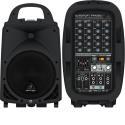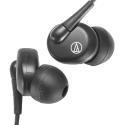
(Editor’s Note: Bear in mind that this is not about one of the recent slang terms “for real for real” used to express agreement, imply honesty, or express disbelief. We refer to its use in audio, not the emphatic version of “for real” or “FR.”)
The pursuit for the perfect guitar tone has been ongoing for years and is a balancing act between the original guitar signal and the added effects. Guitar pedals are commonly used to alter the timbre, and different guitar speakers can also affect sound coloration. However, there are cases where guitarists want their speakers to output their tone without any further coloration. This is where FRFR comes in.
What does FRFR mean? FRFR stands for Full Range, Flat Response, and is a specification that ensures the speaker system is capable of reproducing the full frequency range of an audio signal without any added coloration. It is a term that is commonly used in the audio and live sound engineering world.
An FRFR speaker cabinet is useful for guitarists and bassists who want to achieve consistent sound quality across different venues. It also helps audio and live sound engineers to accurately reproduce the sound from the source without any added coloration or distortion.
In this guide, we will provide a detailed explanation of FRFR, its meaning, and its significance for guitarists, bassists, and audio and live sound engineers.
What Does FRFR Stand For?
FRFR, or full range, flat response, is a type of speaker that reproduces audio signals with high fidelity. The “full range” aspect means it can cover the entire frequency spectrum audible to humans, from around 20Hz to 20Khz. The “flat response” feature means it reproduces audio without any additional coloration or enhancement.

And to clearly represent the frequency fed into the input, FRFR speakers usually come with an HF driver (tweeter) which can handle high frequencies.
It should be noted, however, that even the best FRFR speakers may have slight frequency biases due to manufacturing and brand variations. Generally, a good FRFR speaker should have a frequency response that hovers around +/- 1 to 2 dB in a given frequency.
In practical terms, an FRFR speaker is ideal for guitar players who want to reproduce their effects and tones accurately. With an FRFR speaker, there is no added coloration, so whatever effects or tones are put into the guitar will be accurately reproduced without any additional distortion.
Why use an FRFR Speaker?
To drive the point home, FRFR speakers are neutral sound platforms that provide a transparent representation of the guitar and guitar effects, much like a blank canvas.
Traditional speakers, such as guitar amps or cabinets, have distinct tonal characteristics that can offer different sounds, which some musicians prefer.
However, FRFR (full-range, flat-response) speakers can provide a flat and full-frequency response, making them ideal for users of amp modelers who want full control over the sound and the ability to select the amp tone that best fits their setup.
Unlike a single cabinet, FRFR speakers allow digital amp modeling manufacturers, such as Helix and Headrush, to replicate and reproduce the sound and response of an amp being played through a speaker with greater accuracy.
As a result, FRFR speakers enable users to hear profiles and patches exactly as they should be heard, unaffected by the speaker itself. They behave much like monitor speakers for studio use, only they are being used with instruments and DSP processors.
Guitar Cab vs FRFR Speakers
Guitar cabinets, commonly referred to as cabs, have been a go-to choice for many renowned musicians, including the likes of AC/DC and Metallica, for several years now.
The reason behind their popularity lies in the fact that these cabs can significantly impact the tonal quality of the guitar sound, thereby creating a more unique and personalized timbre.
Much like using an equalizer (EQ) on your amplifier or incorporating an effects pedal to modify the tone, guitar cabs have the ability to color the sound and produce a distinct sonic signature.
Is a guitar cab better than FRFR speakers?
A conventional guitar cabinet features a wooden enclosure that connects to the guitar amplifier, producing the sound of the guitar.
However, Full-Range, Flat-Response (FRFR) speakers differ in that they don’t displace air like traditional cabs. Additionally, if you’re using a modeling amp with a traditional guitar cab, it requires a built-in power amplifier to function.
Pros & Cons Of FRFR Speakers
FRFR speakers are known to have limitations when it comes to live music. Due to the fact that they don’t move air like traditional cabs, they can’t really create the same “blow the roof off” effect as cabs can. For this reason, many rock or metal bands use modeling amps while still incorporating guitar cabs to achieve a more natural, organic sound.
Using a guitar cab requires finding the right mic angle and dealing with potential static noise and bleed. In contrast, FRFR speakers are much simpler to use; you can quickly set up your guitar without worrying about microphone placement or stage setup. All you need to do is plug your modeling amp into the FRFR speaker, and you’re good to go. This allows you to achieve a neutral output studio-perfect sound in seconds.
However, this studio-perfect sound can sometimes come at a cost. FRFR speakers can make the sound a bit isolated and bare, lacking the presence and in room warmth that guitar cabs provide. While amp modelers can replicate various amps, guitar cabs are still advantageous in cutting through the mix more effectively.
FRFR speakers are designed to be neutral, allowing the modeling amp to digitally alter settings via a pedalboard switcher. Conversely, guitar cabs can push air and have a stronger presence in the room. Guitar cabs also provide more options for profiles and tones, including the ability to adjust EQ, add pedals, and move microphones.
Despite the love for guitar cabs, the convenience and utility of FRFR speakers have made them increasingly popular, particularly when paired with amp profilers or modelers. FRFR speakers are highly versatile, allowing musicians to achieve the same sound regardless of venue.
FRFR Speakers Are either Powered or Passive
When choosing a FRFR (full-range, flat-response) speaker, it’s important to consider the question of powered vs passive speakers. The key difference between the two lies in the way they are powered.
Powered FRFRs come with a built-in power supply, whereas passive ones require an external pre-amp to power the speaker. Powered speakers are usually equipped with mini-mixers, allowing them to function as a basic PA system with 1 or 2 inputs.
It’s crucial to review the specifications of the speaker before pairing it with an amplifier. If you use a tube amp to power a speaker meant for a powered FRFR, it could potentially damage the speaker.
Therefore, it’s always better to be cautious and ensure that the speaker and amplifier are compatible before use.
What does FRFR mean for Guitar Processors and Modelling Amps
When it comes to pairing a tube head with an active speaker, the results are usually suboptimal. However, guitar processors and profilers with modelling amp features work well with an FRFR speaker since it doesn’t add any coloration to the already processed guitar sound. This allows you to get the sound that your guitar processor intends, much like a stage monitor.
A non-powered FRFR speaker can also be an intriguing alternative. This setup offers unlimited headroom, making it an excellent option for those who seek high-gain tones without sacrificing clarity.
The sound quality is noticeably superior to that of a regular guitar cab, although personal preferences will ultimately dictate if this setup is suitable for individual players.
It’s worth noting that high-end instruments will always deliver the sound that their manufacturers intended.
Final Thoughts
Full range, flat response (FRFR) speakers have gained popularity in recent years due to their versatility and ability to deliver clean, consistent, and pristine sound. Unlike guitar cabs, FRFR speakers reproduce sound without any coloration or alteration, which makes them ideal for those who want to experiment with different amp tones without investing in an extra cab.
However, using FRFR means you’re required to have technical knowledge and skill. This makes sense as it is crucial to understand the impedance, power handling, and frequency response of the speaker to ensure that it can handle the output of the amp and produce an accurate and balanced representation of the sound.
While guitar cabs have their unique tonal characteristics that many musicians prefer, FRFR speakers offer a more accurate and faithful reproduction of the sound, making them an excellent option for those who prioritize clarity and consistency over warmth and coloration.
Contributors:
- Allen Articulo – Co-writer
- Jerry Borillo – Illustrator





